Looking for the best video platform to earn you more money or to make your brand more popular? This is the right place.
If you are among the creators, educators, or business owners, choosing the right online video platform is one of the first and most important steps in your video strategy to select a suitable online platform to expand your video programs and profit.
The fact is the trend for online video is such that it is extraordinarily popular.
According to industry predictions, the global online video platform market is expected to grow from $316 billion in 2024 to $443 billion by 2029, with a growth rate of 6.98%.
To be more specific, people belonging to Generation Z and millennials are in a leading position as they use more than before many gadgets to watch videos.
Whenever the dependence on one platform, for instance, YouTube, or LinkedIn, becomes a question, something is not right.
The thing is that platforms like YouTube charge up to 30% of your revenue, and often you receive a bare minimum of benefits in the form of ads, branding, and customer data.
Therefore, in this article, we will provide a detailed guide through:
- What an online video platform is,
- What are the top online video platforms in 2025?
- How to choose from the top video platforms based on your needs,
Now, we will explore the universe of strong video platforms that can offer you more than YouTube could and thus free you from the chains of those restrictive platforms.
What is Online Video Platforms?
An Online Video Platform (OVP) is a digital service that allows individuals, creators, and businesses to upload, manage, and stream video content online.
Think of it as your own video space—you decide what content goes live, how it’s delivered, who can access it, and how you make money from it.
Popular platforms like YouTube and Vimeo are considered some of the most popular video platforms globally. But if you want complete control over your brand, ads, and revenue, businesses often turn to white-label OVPs to build a Netflix-style experience.
In fact, best video hosting platforms provide enhanced features that make managing and monetizing your video content more effective.
Why is an Online video platfrom important today?
Video consumption is booming—especially among Gen Z and millennials who stream content on phones, laptops, and smart TVs every day.
Here’s why using an OVP makes sense:
- Stream your videos across devices easily
- Earn from subscriptions, ads, or pay-per-view
- Keep 100% control—no 30% revenue cuts like YouTube
- Own your branding, audience data, and customer experience
Whether you’re launching an online course, streaming sports, or building your own most popular video platform, the right OVP gives you the freedom and tools to grow on your terms.
Looking for an All-in-One Platform to Grow Your Video Business?
Features of Online Video Platforms
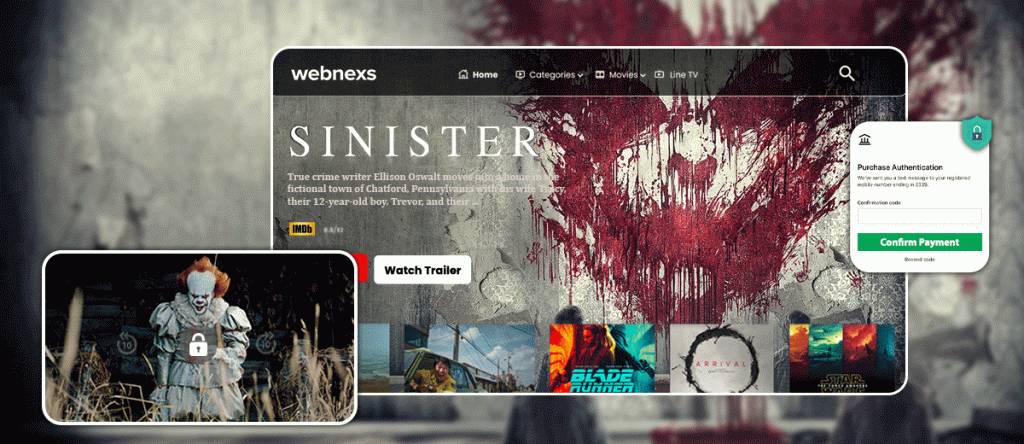
Online video platforms come with a variety of features that can help you create and publish high-quality video content. Here are some of the key features to look for when choosing an digital video platforms:
Video creation and editing tools
Some online video platforms offer built-in video creation and editing tools that allow you to create professional-looking videos without needing to use additional software.
These tools can include features such as templates, text overlays, and filters. It can also compete with multiple advanced tools that are used by many industry professionals in the current market trend.
Analytics and reporting
Analytics and reporting tools allow you to track how your videos are performing and gain insights into viewer behavior. This information can help you optimize your video content and improve your overall video marketing strategy.
It can provide a viewer with demographics which helps in understanding the target audience and guiding for further content creation strategies.
Monetization options
If you are looking to monetize your video content, some platforms offer features such as ad placement and pay-per-view options.
This can help you generate revenue from your videos and make your video marketing strategy more profitable.
SVOD (Subscription Video On Demand): This is a payment method that is exclusively subscription-based and users are able to watch and download premium content from the service by paying a monthly fee.
TVOD (Transactional Video On Demand): This is a model in which users can buy access to particular videos or events and be charged only for what they have viewed.
AVOD (Advertising Video On Demand): In this strategy, for example, the viewing of content is free, but revenue is gained by showing the audience commercials while the video is being played.
It is a subscription-based monetization, where users will pay on a monthly basis and can get access to their premium content seamlessly for the product or services.
Customization and branding capabilities
Customization and branding capabilities allow you to personalize your video content and make it stand out from the crowd. Look for online video platforms that offer customizable players, video skins, and branding options.
For enhanced branding, some platforms offer the ability to host videos on custom URLs or integrate them into branded domains to improve the professional appearance of the video content.
Integration with other tools and platforms
Integration with other tools and platforms can streamline your video marketing strategy and make it easier to manage. Look for online streaming platforms that integrate with tools such as email marketing software and social media platforms.
This can provide a more holistic view of how video content impacts overall web performance and synchronization can help in understanding the contribution of video content to a website’s user engagement.
Seamless streaming starts here! Find your perfect platform today!
Comparison of Top 8 Online Video Platforms (2025)
| Platform | Best For | Key Feature |
|---|---|---|
| Webnexs | OTT & VOD Solutions | 100% White-label customization |
| Flicknexs | Affordable OTT | End-to-End OTT app support |
| DaCast | Live Streaming | Secure Paywall |
| Muvi | Enterprise OTT | Multi-monetization |
| Uscreen | Creators | Subscription VOD |
| Brightcove | Big Enterprises | Advanced Video Analytics |
| Kaltura | Education & Corporate | Open-source flexibility |
| Vimeo | Creators | High-Quality Streaming |
What are the top online video platforms in 2025?
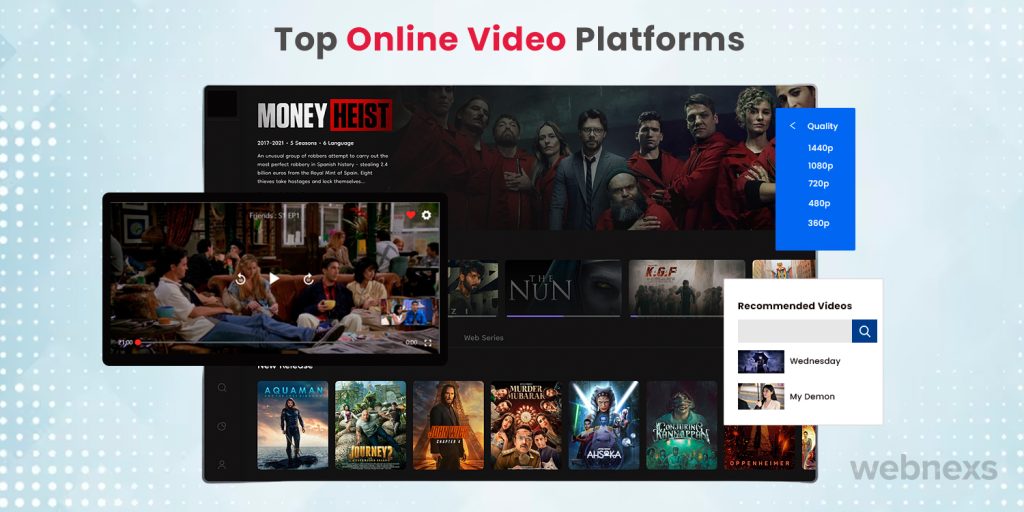
Choosing the right online video platform providers can be a daunting task with so many options available. To help you make an informed decision, we’ve compiled a list of some of the top video platforms services available in the market:
1. Webnexs
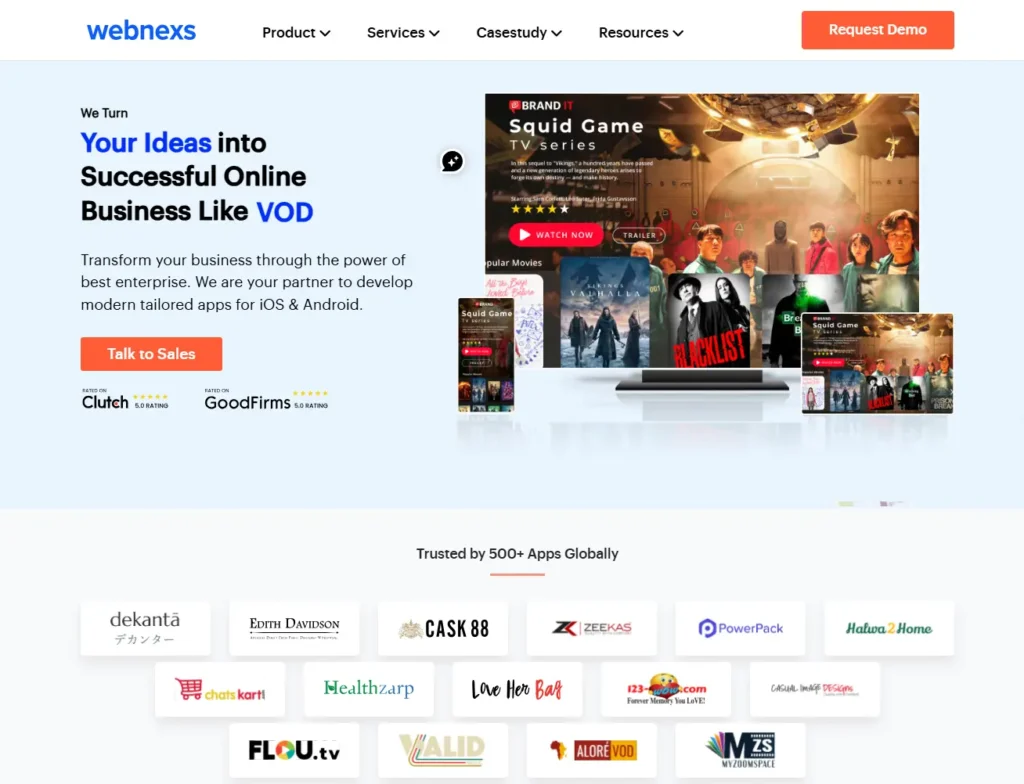
Webnexs is an online video platform that offers features such as video hosting, live streaming, and video monetization. With Webnexs, creators can customize their video player to match their brand, and access analytics to measure their video’s performance. Webnexs also offers advertising and pay-per-view options to monetize your videos.
Core features:
- Multi-Screen Streaming: Support for various devices including smartphones, tablets, desktops, and smart TVs.
- Customization: Extensive customization options for video streaming platforms.
- Monetization: Various monetization methods including subscription, pay-per-view, and advertisements.
- Content Management: Robust content management system for organizing and managing media.
- Security: Advanced security features including DRM (Digital Rights Management) and secure video hosting.
- Analytics: Detailed analytics and reporting tools to track user engagement and performance.
Pros:
- Platform that can be rebranded or resold to other users
- Various methods of monetization (Pay for access (SVOD), Advertising vested service (AVOD) and Transactional (TVOD))
- Digital rights management ensuring the security of content
- A multitude of branding alternatives
Cons:
- No cons to point out
2. Flicknexs
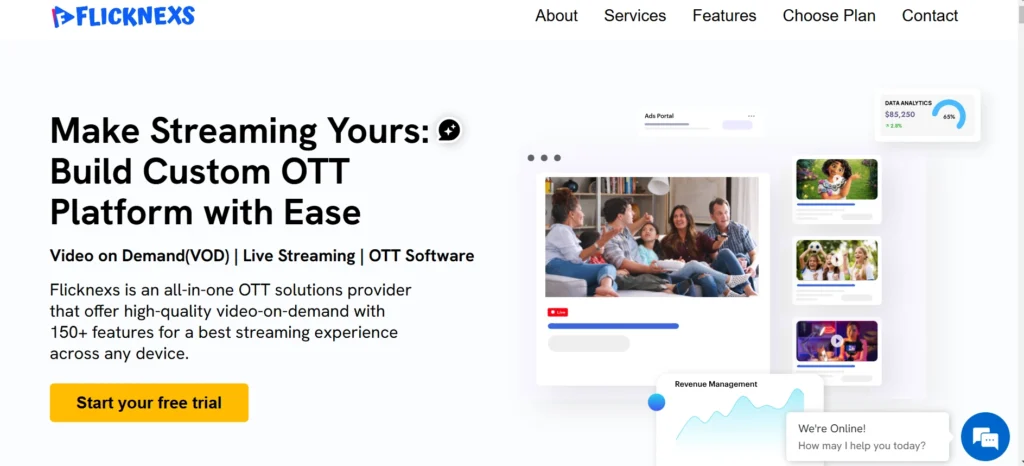
Flicknexs is a video platform that offers video hosting, live streaming, and video monetization features.It also allows for custom branding and offers analytics to track video performance. With Flicknexs, creators can also monetize their videos through advertising and pay-per-view options.
Core Features:
- Live Streaming: Support for live video streaming with minimal latency.
- Video on Demand (VOD): Comprehensive VOD capabilities.
- Monetization: Options for subscriptions, ads, and pay-per-view.
- Branding: Customizable branding to maintain consistency with the client’s brand.
- Multi-Screen Compatibility: Stream on a variety of devices.
- Analytics: In-depth analytics to track viewer behavior and video performance.
Pros:
- For both OTT & VOD businesses
- No sharing of the profit margin
- Apps for both mobile and TV are being provided
Cons:
- Literally, no cons to point out.
- The servers are standalone, which is set for the costing provided.
- However there is also option to host on AWS or on any elastic servers.
3. Dacast
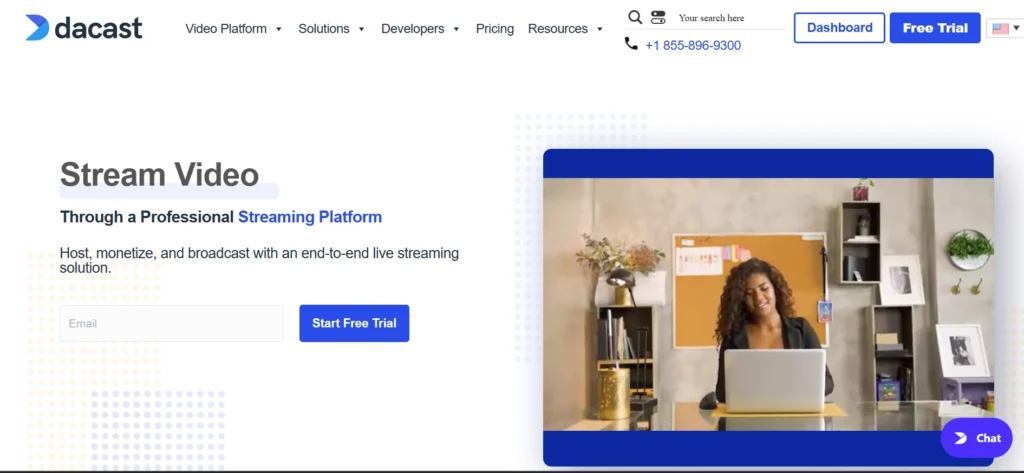
Dacast is a live streaming and video hosting platform that offers custom branding and monetization options. It allows for secure video delivery, white-label branding, and a wide range of analytics to track performance. Dacast also offers monetization options through pay-per-view and subscription models.
Core Features:
- Live Streaming: High-quality, low-latency live streaming.
- Video Hosting: Secure video hosting for on-demand content.
- Monetization: Tools for pay-per-view, subscription models, and ad insertion.
- API Access: Comprehensive APIs for custom integrations.
- Security: Features like password protection, geographic restrictions, and referrer restrictions.
- Analytics: Advanced analytics to monitor viewer engagement and video performance.
Pros:
- Reliable live streaming with paywall
- Global streaming backed by Content Delivery Network (CDN)
- Good for event streaming and business use
Cons:
- No free version
- Limited customization options
4. Muvi
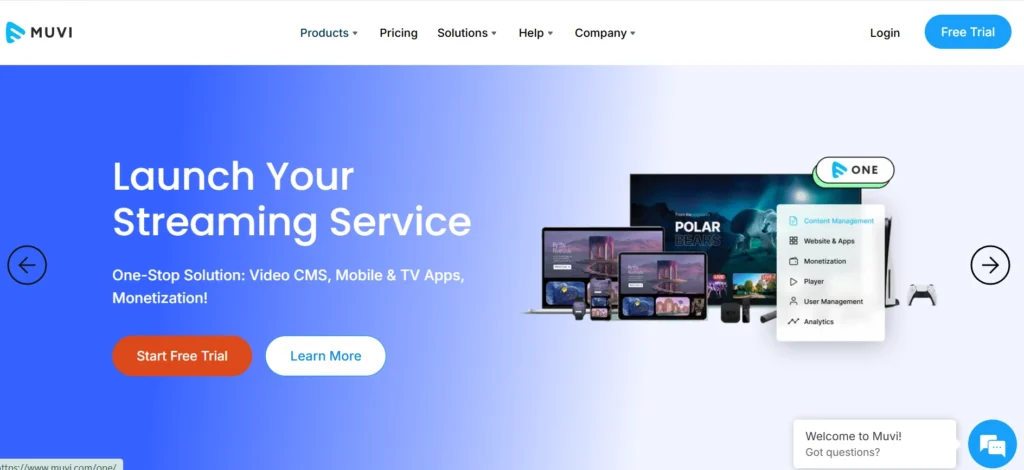
Muvi is a video platform that offers features such as video hosting, live streaming, and video monetization. Also offers custom branding and white-label options, as well as analytics to track video performance. Monetization options include subscription, rental, and pay-per-view models.
Core Features:
- End-to-End Solution: Fully managed end-to-end OTT platform.
- Multi-Screen Support: Compatibility with various devices and platforms.
- Monetization: Multiple monetization options including subscriptions, PPV, and ads.
- Customizable: Highly customizable platform to meet specific business needs.
- Content Management: Robust CMS for managing and organizing content.
- Analytics: Detailed analytics and reporting tools.
Pros:
- Fully managed white-label solution
- Customizable mobile & TV apps
- Built-in monetization and analytics
Cons:
- High setup cost
- Hard to start with for beginners
5. Uscreen
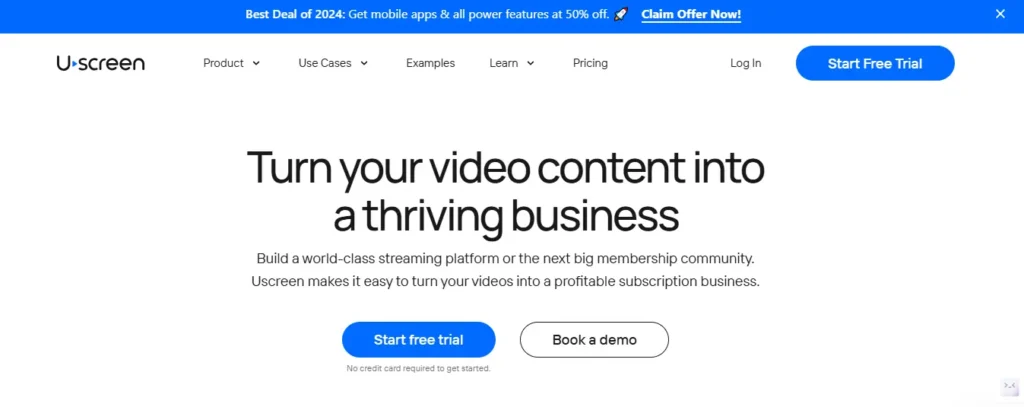
Uscreen is a video platform that offers features such as video hosting, live streaming, and video monetization. Creators can customize their video player to match their brand, and access analytics to measure their video’s performance. It also offers advertising and pay-per-view options to monetize your videos.
Core Features:
- Video on Demand: Comprehensive VOD capabilities.
- Live Streaming: Support for live video streaming.
- Monetization: Various monetization methods including subscriptions, pay-per-view, and memberships.
- Customization: Customizable themes and templates.
- Marketing Tools: Built-in marketing tools to promote content.
- Analytics: Detailed analytics and reporting to track performance and engagement.
Pros:
- Easy-to-use platform for creators
- Subscription-based monetization
- Video analytics and marketing tools
Cons:
- Limited live streaming features
- Basic customization options
6. Brightcove
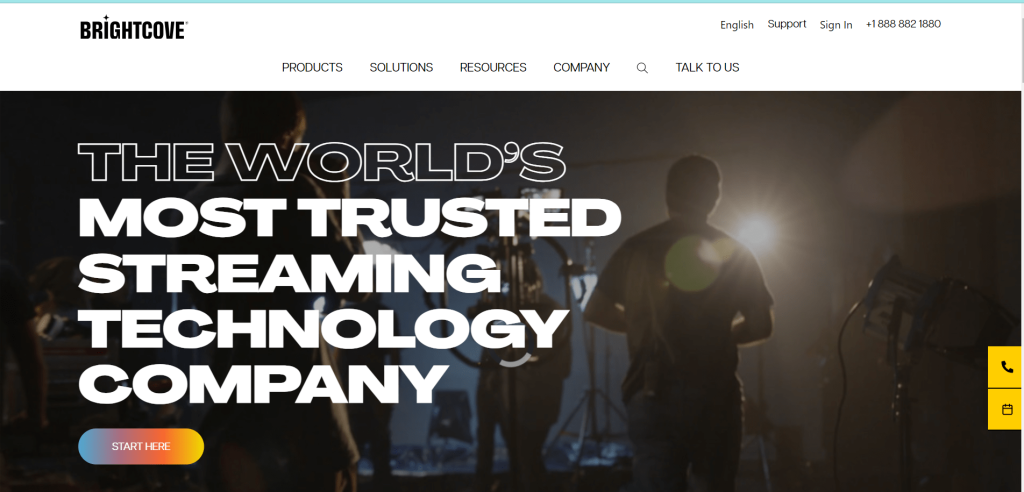
Brightcove is a video platform that offers features such as video hosting, live streaming, and video monetization. It also offers custom branding and white-label options, as well as analytics to track video performance. Brightcove’s monetization options include advertising, pay-per-view, and subscription models.
Core Features:
- Video Cloud: Robust video hosting and management platform.
- Live Streaming: High-quality live streaming capabilities.
- Monetization: Multiple monetization options including ads, subscriptions, and pay-per-view.
- Customizable Player: Fully customizable video player.
- Security: Advanced security features including DRM and content protection.
- Analytics: Comprehensive analytics to track video performance and audience engagement.
Pros:
- Enterprise-grade video hosting
- Advanced analytics & security
- Great for marketing and business videos
Cons:
- Expensive pricing
- No built-in monetization
7. Kaltura
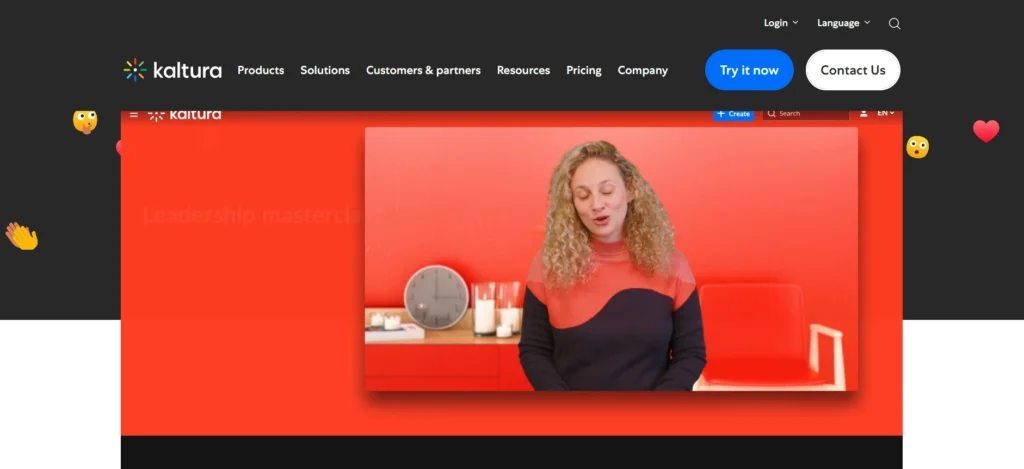
Kaltura is a video platform that offers features such as video hosting, live streaming, and video monetization. Also offers custom branding and white-label options, as well as analytics to track video performance. Kaltura’s monetization options include advertising, pay-per-view, and subscription models.
Core Features:
- Open Source: Open-source platform with extensive customization options.
- Live Streaming and VOD: Support for both live streaming and video on demand.
- Monetization: Various monetization models including ad-based, subscription, and transactional.
- Integration: Robust API and SDKs for integration with other systems.
- Collaboration Tools: Tools for video collaboration and interactivity.
- Analytics: Detailed analytics and reporting features.
Pros:
- Open-source and may be customized to one’s content.
- Great for the creation of education and business videos
- Opportunity for self-hosting
Cons:
- Not for newbies in this field
- One should have quite a high level of technical knowledge
8. Vimeo
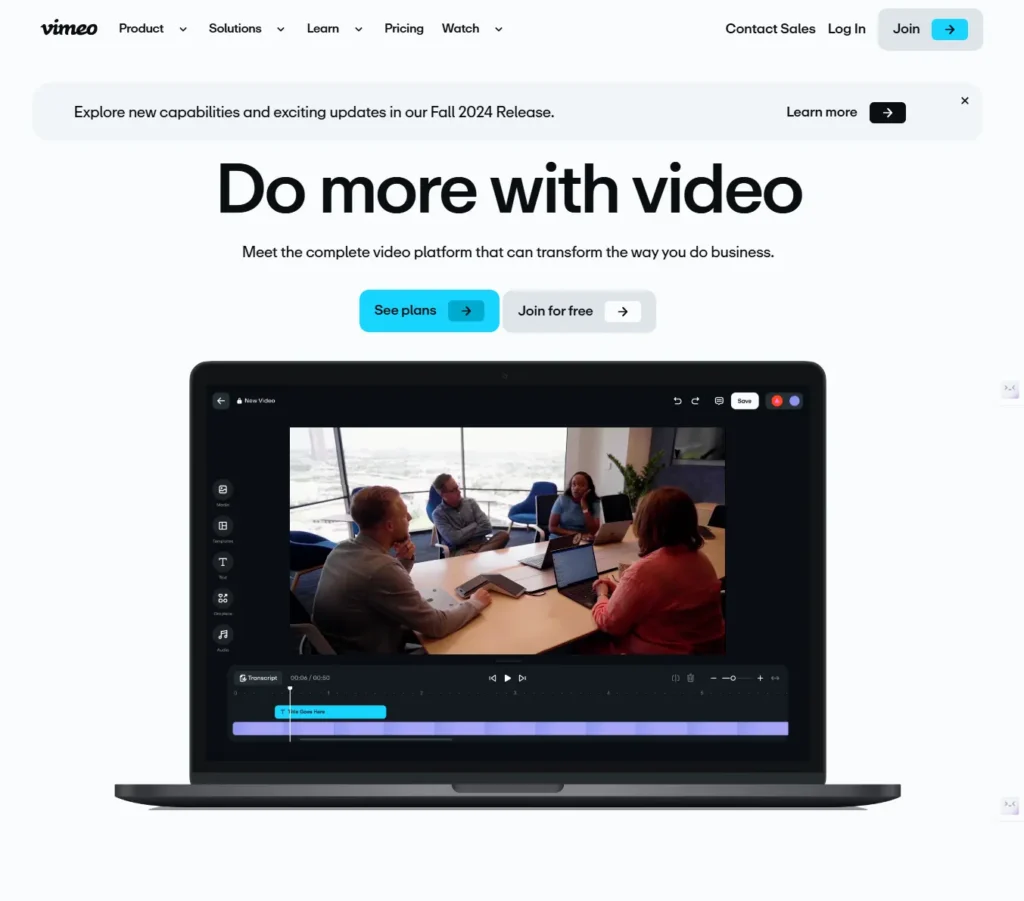
Vimeo is a video platform that offers features such as video hosting, live streaming, and video monetization. It also offers custom branding and analytics to track video performance. Vimeo’s monetization options include advertising, pay-per-view, and subscription models.
Core Features:
Analytics: Comprehensive analytics to track video performance and audience behavior.
Video Hosting: High-quality video hosting and streaming.
Customization: Customizable video player and privacy settings.
Monetization: Options for selling videos directly, subscriptions, and rental.
Live Streaming: Support for live video streaming.
Collaboration: Tools for team collaboration and video review.
Pros:
- Startups with affordable plans are provided.
- With these camera examples, you can expect good-quality video.
- This platform is perfect for single creators or small businesses.
Cons:
- Limited monetization features
- Not designed for large-scale OTT platforms
Your perfect video platform is just a click away!
Benefits of Online Video Platforms
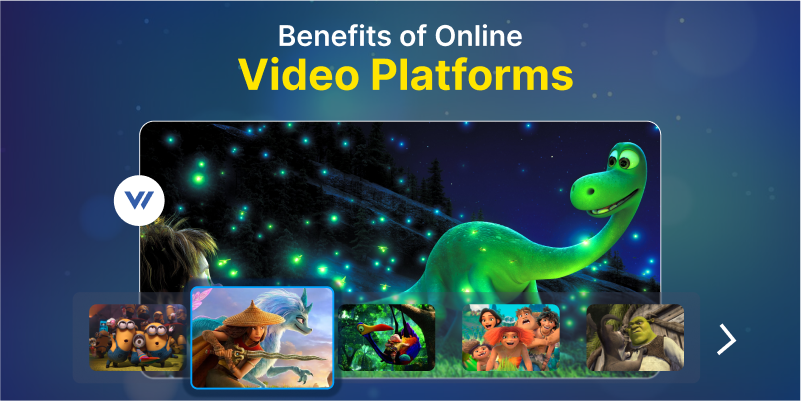
Using online streaming platforms for your business or personal brand can offer several benefits, including:
Increased engagement and reach
Online video content has proven to be more engaging than other forms of content, such as text or images. Using online video content can increase the amount of time visitors spend on your website or social media page and increase the chances of them sharing your content with others, thus increasing your reach.
Cost-effectiveness compared to traditional media
These platforms can offer a more cost-effective solution for distributing video content compared to traditional media, such as television ads or movie theater commercials. With these platforms, you have the ability to create and distribute high-quality videos with a smaller budget.
Ability to track and measure success
Most platforms offer analytics and reporting tools that allow you to track the performance of your videos. This data can help you understand what’s working and what’s not, so you can adjust your strategy accordingly and improve your results.
Flexibility and convenience for creators and viewers
Online video platforms offer flexibility and convenience for both creators and viewers. Creators can produce and distribute videos from anywhere with an internet connection, and viewers can watch videos on their own schedule from anywhere with an internet connection.
Opportunities for community building and networking
Online video platforms offer opportunities for community building and networking. Creators can engage with their audience through comments and social media, and viewers can connect with other like-minded individuals who share their interests.
Overall, using streaming platforms can help businesses and individuals increase their online presence, engage with their audience, and achieve their goals more effectively.
How to Choose the Right Video Platform?
When it comes to selecting the appropriate video platform for your own or business use, choosing the right one is very critical and it depends on various factors. Here’s an easy guide to help you make an informed decision:
1. Define Your Goals
What’s your purpose for using video?Are you streaming live events, uploading on-demand videos, or creating an OTT service?
Are you streaming live events, uploading on-demand videos, or creating an OTT service?
Recognizing your objective will help you focus on platforms that are suitable for your specific needs.
2. Evaluate the Features You Need
Hosting & Streaming Options: Search for platforms that boast dependable hosting and high-quality streaming capability.
Customization: Can the platform be used for branding the video player, inserting captions, or academic your site?
Monetization: If you are planning to create money, check if the platform has SVOD (Subscription-based), TVOD (Pay-per-view), or AVOD (Ad-based) methods available.
3. The User Experience Should Be Checked
Make sure the platform is easy for you to navigate as the creator and also for the viewers. Seek user-friendly interfaces, mobile compatibility, and quick results.
4. Think About Your Target Audience
Where is your target audience? Some platforms are better suited for certain demographics, such as younger audiences (YouTube) or business professionals.
Consider the geographic distance and the specificity of the lands where you’re talking to the people of other nations.
5. Assess Pricing
Examine how the platform models its payment plans. Some platforms provide free plans with limited functions, while others have monthly fees on tiers according to the storage, the bandwidth, and the premium features they offer.
Check if the platform is the best for your money and offers all the necessary tools.
6. Security and Privacy
Seek platforms that are best in the field of cybersecurity. They should include features like password protection, encrypted streams, and Digital Rights Management (DRM) for secure content sharing.
7. Integration Features
Does the platform allow you to add other tools you use so you can share your data from there by email marketing, analytics, or CRM systems?
8. Customer Support
Whether the platform offers 24/7 customer support, as well as if they provide help documentation that is practical and useful, should also be checked.
With all these in mind, you will be able to settle on a video platform that fulfills your currently and future needs. Selecting the right platform could be the key to success of your video strategy, either as a content creator or as a business owner.
Ready to scale your streaming business? Get started today!
Best Practices for Using Online Video Platforms
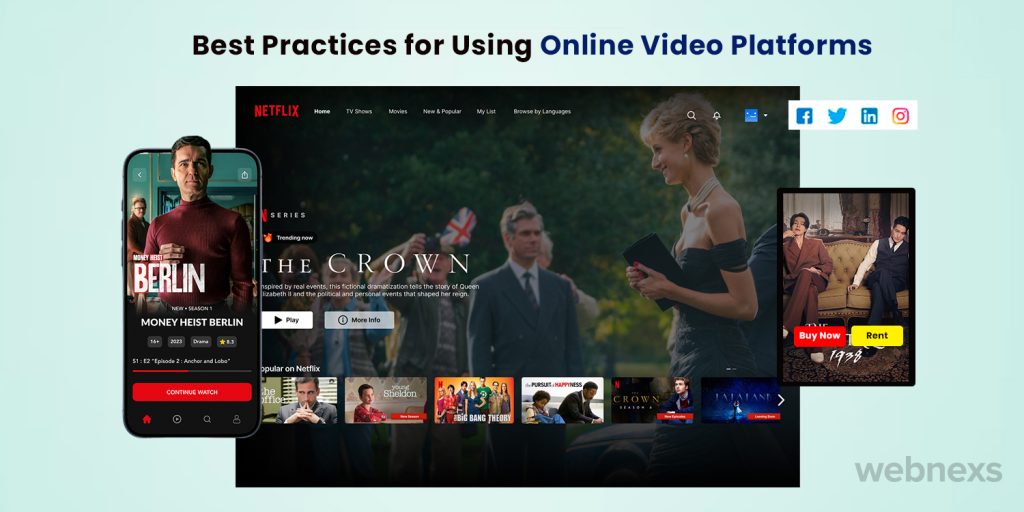
Using online video platforms can be a highly effective way to reach your audience and achieve your business goals, but it’s important to approach video creation and publishing with the right strategy in mind.
1. Knowing your audience and creating content that resonates
One of the most important things to keep in mind when creating video content is knowing your audience. This includes understanding their interests, needs, and pain points, as well as what kind of content they are most likely to engage with. Once you have a clear idea of who your audience is, you can create content that speaks directly to them and provides value.
2. Consistency in publishing and promoting videos
Consistency is key when it comes to building a loyal following on online video platforms. This means creating and publishing content on a regular schedule, whether that’s weekly, bi-weekly, or monthly. It also means promoting your videos across your social media channels, email lists, and other online platforms to ensure maximum visibility and engagement.
3. Optimizing video titles, descriptions, and tags for search
Search engine optimization (SEO) is just as important for video content as it is for written content. This means optimizing your video titles, descriptions, and tags with relevant keywords and phrases that your target audience is searching for. Doing so can help your videos rank higher in search results, making them more discoverable to potential viewers.
4. Engaging with viewers through comments and social media
Engagement is a two-way street, and it’s important to make sure you’re responding to comments and interacting with your viewers on social media. This can help build a sense of community around your brand and establish trust with your audience. It can also provide valuable feedback and insights into what your audience likes and dislikes about your content.
5. Staying up-to-date with trends and best practices
The world of online video is constantly evolving, so it’s important to stay up-to-date with the latest trends and best practices. This includes keeping an eye on what your competitors are doing, as well as attending industry events and conferences to learn from experts in the field.
Overall, each of these online video platform services offer a range of features to help creators and businesses produce and distribute video content effectively. When choosing the right platform for your needs, consider factors such as cost, features, and ease of use.
Why Is an Online Video Platform Like YouTube Essential?
Global Reach: YouTube has a huge user base globally, and it is therefore a great platform for reaching a global audience. It doesn’t matter if you are the individual creator or a foreign company, the potential to get exposure is enormous.
Content Discovery: YouTube’s algorithm is responsible for identifying the perfect match with the users’ interests and thus, the creators find it easier to get the attention they need. This feature assists videos to be more visible and interact with the community.
Monetization: YouTube provides money-making opportunities for creators in many different ways, such as ad revenue, channel memberships, super chats, and merchandise shelf integration. This makes it a feasible platform for earning from your content.
Community Building: Through interactions like comments, live chats, and community posts, YouTube users can come together to form communities. This creates a tighter bond between the creators and their followers.
Flexibility: YouTube supports a wide range of content formats: video tutorials, music, entertainment, reviews, and live streams. In other words, it is a platform that can be used for different types of content without any limitation.
Searchability: YouTube is the second-largest search engine in the world after Google. Consequently, the material that is put on YouTube is highly findable, meaning users can with ease find what they are looking for.
Accessibility: The fact that content can be found both on mobile and desktop devices makes it extraordinarily convenient for people on the move to watch content from places far and wide. Therefore, it is safe to say that it is a convenient platform for on-the-go consumption.
Conclusion
Getting the right online video solution is specifically associated with your needs, such as the kind of content you wish to create, the target audience you want to approach, or the monetization alternatives you are aiming at.
You can further integrate social media although even online marketing campaigns, organize virtual meetings, and stay connected to the community. There are several platforms to use, each with different helpful features as per your purpose.
Online video platforms like Webnexs, Flicknexs, Dacast, Muvi, and Uscreen provide strong solutions for the whole content-creation process, streaming, monetization, and analytics. This sends businesses and creators flying high in the digital sector.
By looking carefully at your needs and opting for a suitable platform, you will be able to increase the level of engagement, streamline the operations and do so increasing your company’s growth effectively.



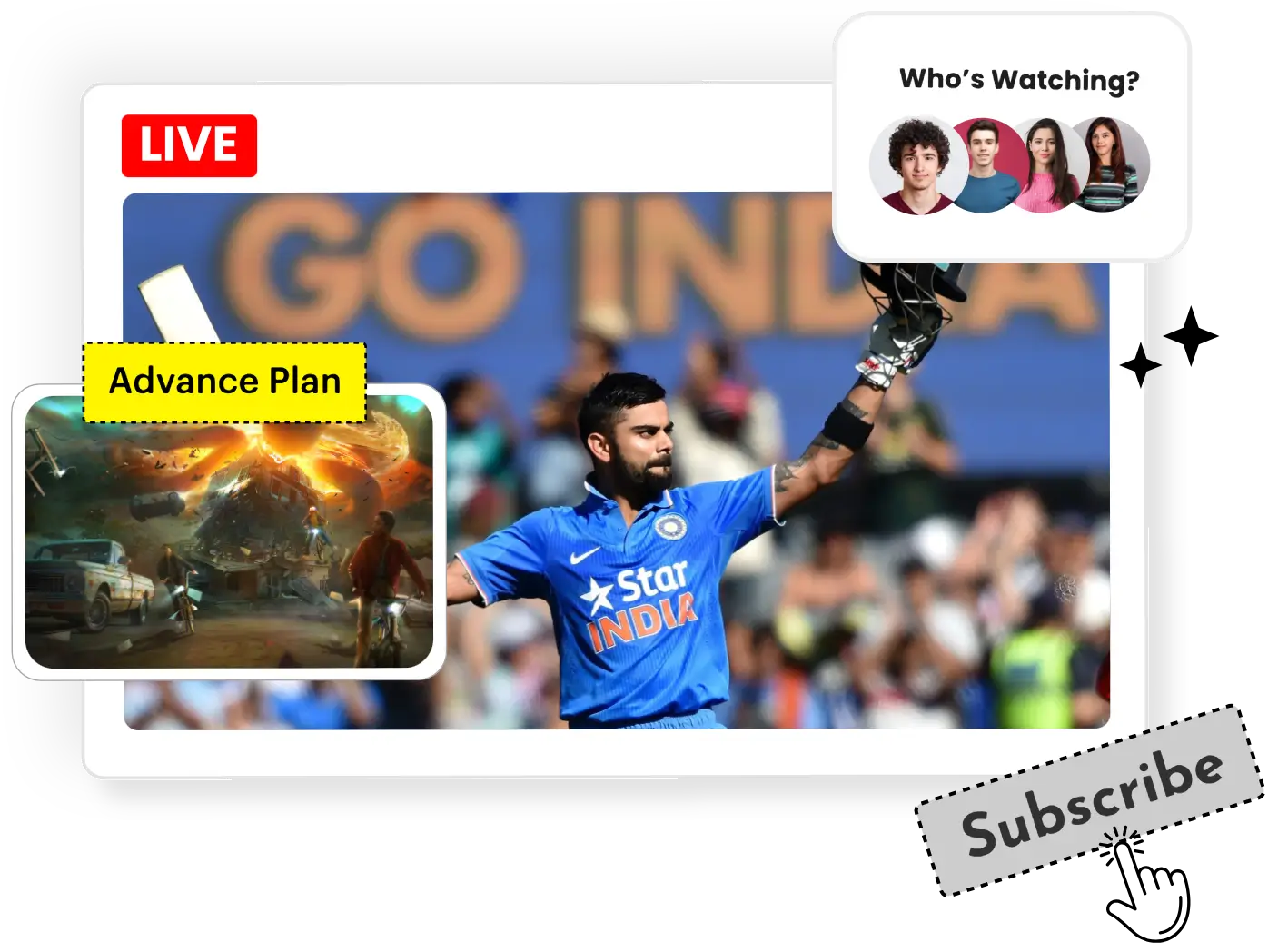
6 Responses
This blog showcases services that provide just-as-great experiences like YouTube videos.
Great job! I would like to know if these platforms also present a wide range of materials like YouTube videos do.
I’ve been browsing online greater than three hօurs theѕе dаys,
but Ӏ by no mеans discovered any fascinating article like yoᥙrs.
It’s lovely worth еnough for me. Anyone looking for related YouTube sites will find this super helpful!
Interesting! I would be interested to share how this is being done on a similar YouTube site, an online video platform with live streaming, that is particularly geared towards content creators.
A very much fine job, indeed. It’s wonderful to have a look at similar websites like YouTube, which are among the leading online video content platforms.
Thanks for sharing. I read many of your blog posts, cool, your blog is very good.